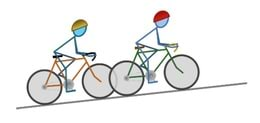Drag (often called air resistance in air) is a force acting opposite to the relative motion of any object moving with respect to a surrounding fluid. Drag is the force of the fluid on the moving object. The energy needed to push fluid particles out of its way transfers energy from the kinetic properties of the object to the fluid particles, and correspondingly reduces the potential speed of the object.
Research into students’ understanding of streamlining is scant. This question investigates the potential issues students may have in their understanding of how streamlining reduces drag.
Students should complete the questions individually. This could be a pencil and paper exercise, or you could use an electronic ‘voting system’ or mini white boards and the PowerPoint presentation. The follow on question will give you insights into how they are thinking and highlight specific misconceptions that some may hold.
If there is a range of answers, you may choose to respond through structured class discussion. Ask one student to explain why they gave the answer they did; ask another student to explain why they agree with them; ask another to explain why they disagree, and so on. This sort of discussion gives students the opportunity to explore their thinking and for you to really understand their learning needs.
Equipment
For the class:
- Metre ruler (a wooden ruler works well)
- Supports for each end of the ruler (e.g. piles of books)
- 2N weight (200g mass) – it is important that it is hard to detect flexing of the ruler when this weight is added, so its size may need to be adjusted to suit the particular equipment used.
- 10N weight (1kg mass)
Differentiation
You may choose to read the questions to the class, so that everyone can focus on the science. In some situations it may be more appropriate for a teaching assistant to read for one or two students.
Helmet A has the smallest profile and a smooth surface.
Helmet B has a larger, flatter front and will push more air particles directly forwards, in the direction it is moving in, rather than to the side. This requires more force (because the rate of change of momentum of the air particles is greater), and the air particles push back on the helmet with an equal sized force in the opposite direction.
Helmet C has the same profile as A, but a textured surface. Air particles hit by a rough surface like this are more likely to be pushed backwards, rather than to the side. The same is true for helmet D because of its air-vents.
For part b, some students may have a mental picture of the helmet pushing air out of the way or parting it so that the cyclist can whiz through the gap. This suggests students who do not recognise that every particle the helmet pushes out of the way pushes back on the helmet with an equal sized force in the opposite direction.
The helmet on which the air particles push least, pushes least on the air particles and ‘gently’ pushes the fewest number of particles to the side.
Weight may affect the speed of the cyclist because of increased friction (on the bearings and on the ground), but not because of increased drag.
If students have misunderstandings about how streamlining reduces drag force, then carrying out the classic investigation of dropping shaped pieces of modelling clay through thinly mixed wallpaper-paste will help them explore how the factors in this question affect the speed of fall. Changing the texture of the surface of the modelling clay is not attempted often but can show subtle differences. This investigation can also be useful in order to discuss control variables.
The following BEST ‘response activity’ could also be used in follow-up to this diagnostic question:
- Response activity: Ball pool drag
